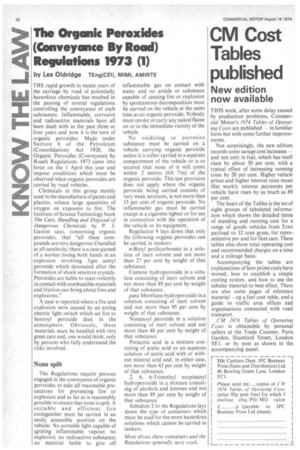The Organic Peroxides (Conveyance By Road) Regulations 1973 (1)
Page 34

If you've noticed an error in this article please click here to report it so we can fix it.
by Les Oldridge TEng(CEI), MIMI, AMIRTE THE rapid growth in recent years of the carriage by road of potentially hazardous chemicals has resulted in the passing of several regulations controlling the conveyance of such substances. Inflammable, corrosive and radioactive materials have all been dealt with in the past three or four years and now it is the turn of organic peroxides. Made under Section 6 of the Petroleum (Consolidation) Act 1928, the Organic Peroxides (Conveyance by Road) Regulations 1973 came into force on the I April this year and impose conditions which must be observed when organic peroxides are carried by road vehicles.
Chemicals in this group mainly used in the manufacture of paints and plastics, release large quantities of oxygen on exposure to fire. The Institute of Science Technology book The Care, Handling and Disposal of Dangerous Chemicals by P. J. Gaston says, concerning organic peroxides, that "all these compounds are very dangerous if handled at all carelessly; there is a case quoted of a worker losing both hands in an explosion involving 5 gm acetyl peroxide which detonated after the formation of shock sensitive crystals. Peroxides are liable to react violently in contact with combustible materials and friction can bring about fires and explosions."
A case is reported where a fire and explosion were caused by an arcing electric light switch which set fire to benzoyl peroxide dust in the atmosphere. Obviously, these materials must be handled with very great care and, one would think, only by persons who fully understand the risks involved.
None spilt
The Regulations require persons engaged in the conveyance of organic peroxides to take all reasonable precautions for preventing fire or explosion and as far as is reasonably possible to ensure that none is spilt. A suitable and efficieat fire extinguisher must be carried in an easily accessible position on the vehicle. No portable light capable of igniting inflammable vapour; no explosive; no radioactive substance; no material liable to give off inflammable gas on contact with water and no article or substance capable of causing fire or explosion by spontaneous decomposition must be carried on the vehicle at the same time as an organic peroxide. Nobody must smoke or carry any naked flame on or in the immediate vicinity of the vehicle.
No oxidizing or corrosive substance must be carried on a vehicle carrying organic peroxide unless it is either carried in a separate compartment of the vehicle or is so secured that none of it will come within 2 metres (oft 7 in) of the organic peroxide. This last provision does not apply where the organic peroxide being carried consists of very weak mixtures, ie not more than 15 per cent of organic peroxide. No inflammable gas must be carried except in a cigarette lighter or for use in connection with the operation of the vehicle or its equipment Regulation 9 lays down that only the following organic peroxides can be carried in tankers: n-Butyl perdicarbonate in a solution of inert solvent and not more than 27 per cent by weight of that substance.
Cumene hydroperoxide in a solution consisting of inert solvent and not more than 95 per cent by weight of that substance.
para Menthane hydroperoxide in a solution consisting of inert solvent and not more than 95 per cent by weight of that substance.
Nonanoyl peroxide in a solution consisting of inert solvent and not more than 40 per cent by weight of that substance. .
Peracetic acid in a mixture consisting of acetic acid or an aqueous solution of acetic acid with or without mineral acid and, in either case, not more than 42 per cent by weight of that substance.
2, 6, 6-Trimethyl norpinanyl hydroperoxide in a mixture consisting of alcohols and ketones and not more than 95 per cent by weight of that substance.
Schedule 2 to the Regulations lays down the type of containers which must be used for the more hazardous solutions which cannot be carried in tankers.
More about thew containers and the Regulations generally next week.




























































































